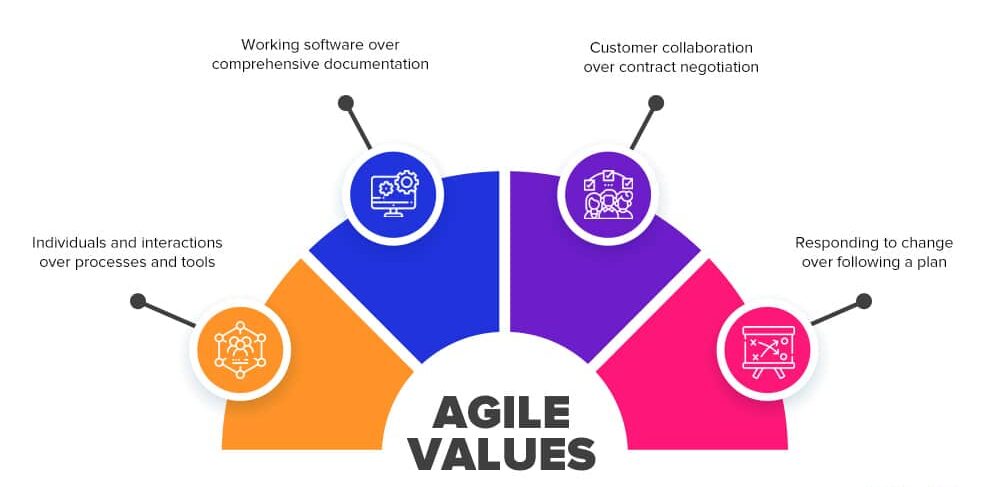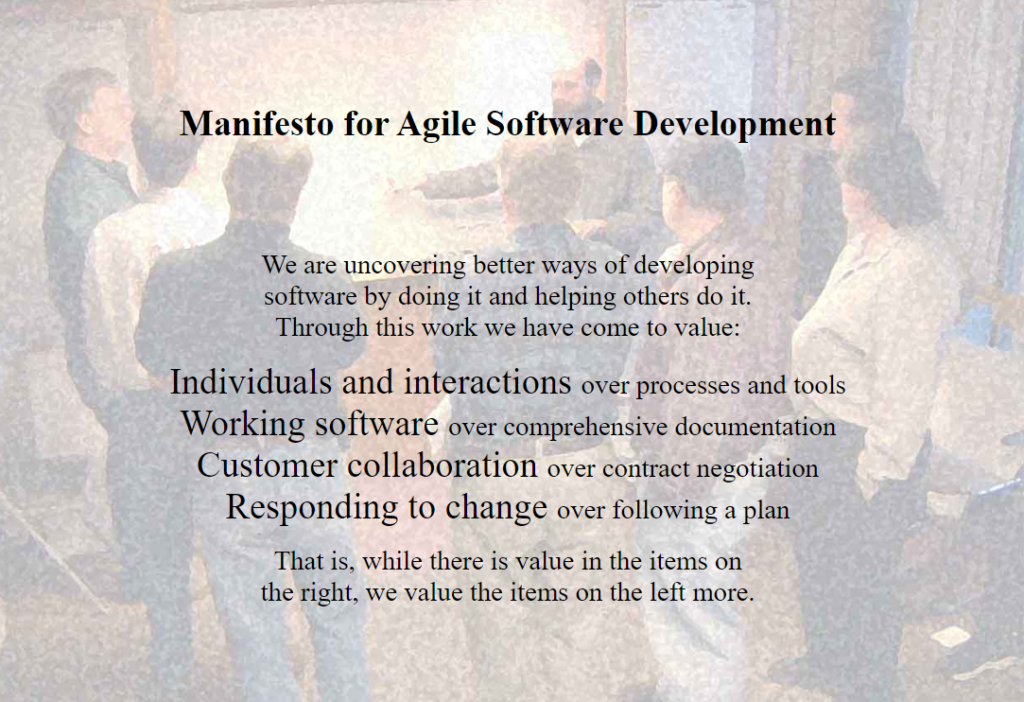The True Soul of Agile: Navigating Beyond the Hype
In today’s swiftly evolving tech landscape, methodologies that streamline and enhance software development processes are in high demand. Agile, a popular methodology, has transformed the software development world. However, its rise has not been without controversy.
Some might argue that the mere mention of the word “Agile” incites a visceral and negative reaction. Why? Agile has become a lucrative business, spawning hundreds, if not thousands, of so-called “Agile” coaches, trainers, and competing frameworks and methods. This proliferation has led to its misapplication, often resulting in increased interference with developers, undue pressure, and demands for speed. In many cases, poor implementation of Agile principles has resulted in higher defects and slower progress. Good developers, feeling the brunt of these missteps, sometimes leave these organizations, thereby reducing the organization’s effectiveness.
However, such criticisms often stem from misunderstandings or misapplications of Agile. Authentic Agile, as its creators intended, centers around the Agile Manifesto’s principles.
In the context of agencies, these principles are still relevant. While agencies might not have the luxury of hiring a full-time employee for every Agile role, they can still embrace the underlying concepts.
Adapting Agile for Agencies
Individuals and Interactions Over Processes and Tools
Agencies thrive on human interaction. Strong communication and collaboration between team members and clients is paramount. Agencies should focus first on fostering strong relationships and transparent interactions, ensuring everyone is aligned and working towards common goals.
Working Software Over Comprehensive Documentation
Instead of investing significant time in extensive documentation, agencies can prioritize creating tangible results. Delivering working prototypes or sections of a project can provide clients with something concrete, offering immediate value and facilitating feedback.
Customer Collaboration Over Contract Negotiation
In an agency setting, client relationships are everything. By emphasizing collaboration over rigid contract terms, agencies can build trust, ensuring a more cooperative and productive working relationship.
Responding to Change Over Following a Plan
The dynamic nature of agency projects, with shifting client needs and market conditions, requires flexibility. Adhering strictly to a plan can be detrimental. Instead, agencies can benefit from an adaptive approach, adjusting strategies based on real-time insights and feedback.
But there’s more to Agile than just these principles. Drawing from Lean Six Sigma, a methodology focused on eliminating waste and reducing variability in processes, agencies can further refine their Agile practices. By integrating the tenets of Six Sigma Lean with Scrum, agencies can extract the best parts of both, leading to efficient processes and satisfied teams.
Roles Within Agile
The Agile methodology, while often associated with software development, encompasses a much broader range of roles than just coders. Understanding the diverse roles in an Agile setup can provide a comprehensive view of how projects evolve from conception to completion.
Developers: They’re responsible for writing the code. Their deep technical knowledge ensures the software’s functionality aligns with the requirements.
Testers: Their primary role is to identify bugs or inconsistencies in the software. They ensure the final product is free from technical glitches and meets quality standards.
Designers: Often overlooked in strictly technical discussions, designers play a crucial role in Agile. They’re responsible for the user interface and experience, ensuring that the software is not only functional but also user-friendly.
Business Analysts: They act as a bridge between non-technical stakeholders and the development team. Business analysts gather requirements, clarify ambiguities, and ensure the software aligns with business objectives.
Product Owners: They prioritize the backlog, ensuring that the most critical features are developed first. They provide direction, ensuring the project stays aligned with its intended goals.
Scrum Masters: While not directly involved in product development, Scrum Masters facilitate the Agile process. They resolve blockers, ensure the team adheres to Agile principles, and foster a collaborative environment.
Each of these roles brings a unique perspective to the project. In Agile, collaboration is paramount, and the interplay between these roles ensures a well-rounded final product. The diversity of roles underscores the holistic nature of Agile: it’s not just about coding but about creating a solution that meets business objectives and resonates with end-users.
The Nuances of Deadlines
Deadlines in Agile are more than just dates on a calendar; they serve as motivators, guiding the team towards timely delivery. However, understanding the nature of these deadlines is crucial to harness their potential without succumbing to undue stress.
Purpose of Deadlines: Deadlines in Agile act as a structured approach to manage work. They help in breaking down a vast project into manageable chunks, ensuring a systematic progression.
Flexibility: While deadlines provide a timeline, they’re not set in stone in Agile. If a team requires eight weeks to complete a six-week project or four weeks to finish a task allocated three weeks, it’s acceptable. The focus is on delivering quality, even if it necessitates a slight extension.
Pressure vs. Motivation: Deadlines should motivate, not pressurize. A consistent, gentle push ensures work progresses at a steady pace. However, overburdening teams with unrealistic expectations can be counterproductive, leading to rushed jobs and compromised quality.
Recurring Deadlines, i.e. Sprints: The concept of sprints in Agile introduces recurring deadlines. Whether two weeks or a different duration, sprints provide regular checkpoints, ensuring the team stays on track. While the duration might seem arbitrary, the regularity offers predictability, aiding in planning and resource allocation.
Deadlines as Events: In Agile, deadlines can also be event-based, not just time-based. A sprint could remain open until all its tasks are completed. This approach emphasizes deliverables over strict timelines, ensuring that quality isn’t compromised for the sake of meeting a date.
Neurochemistry and Deadlines: Meeting deadlines has a profound psychological impact. Completing tasks within the stipulated time releases serotonin, a neurochemical associated with happiness and satisfaction. However, consistently missing deadlines or working under extreme pressure can increase stress levels, affecting team morale and overall well-being.
While deadlines are essential in Agile, their true purpose is to streamline work, not to add stress. By understanding and respecting the nuances of deadlines, teams can leverage their benefits while maintaining a healthy, productive work environment.
Neurochemistry in the Agile Framework – The EDOS Method
The human body naturally produces a number of neurochemicals which are partially responsible for regulating our emotions and energy levels. There are some automatic processes that are out of our control, but having an understanding of the fundamentals of the function of certain chemicals goes a long way. The explanations below are brief, but they should help you to understand their role in our process. They work in order: E-D-O-S, and when done well they serve us as a reliable methodology to approach our work.
-
Endorphins: In this context, think of this as the ‘excitement’ chemical.
-
Dopamine: Released during moments of reward, promoting pleasure and motivation.
-
Oxytocin: Known as the ‘bonding molecule’, it enhances social bonding and trust.
-
Serotonin: Associated with feelings of happiness and contentment upon achievement.
-
Cortisol: Released in response to stress, prolonged levels can lead to burnout.
In the Agile framework, particularly within the Scrum ceremonies, the interplay of tasks and neurochemistry is evident:
E – Kicking Off a New Sprint: The anticipation and excitement of starting a fresh sprint, with new challenges and opportunities, can trigger the release of endorphins. This provides an initial boost of enthusiasm and energy to the team.
D – Moving Tickets on the Board: The tangible act of shifting tickets or tasks from ‘To Do’ to ‘Done’ on a Kanban or Scrum board releases dopamine. This simple act provides a sense of achievement and progress, motivating the team to push forward.
O – Collaborative Teamwork: As team members work together, helping each other, sharing knowledge, and achieving common goals, there’s a release of oxytocin. This fosters a sense of camaraderie, trust, and unity within the team.
S – Completion of a Sprint: Successfully wrapping up a sprint, achieving the set goals, and reflecting on the accomplishments leads to the release of serotonin. This provides a sense of contentment, pride, and happiness for a job well done.
To maximize the benefits of this neurochemical interplay, it’s crucial for Project Managers to emphasize the importance of celebrating sprint completions. A genuine, joyful celebration not only marks the end of a successful sprint but also ensures a serotonin boost, which team members invariably love and appreciate. This not only elevates mood but also instills a sense of purpose and motivation for upcoming sprints.
Dark Scrum
“Dark Scrum” emerges when the principles of Scrum, which are fundamentally about empowerment and collaboration, become distorted in practice. While Scrum aims to provide a productive environment where team members self-organize and have clear communication with stakeholders, Dark Scrum deviates significantly from these ideals. At its core, Dark Scrum feels oppressive, particularly for developers, making them feel more burdened than empowered.
In Dark Scrum, the ceremonies become mere routines, devoid of their true essence. For instance, instead of self-organizing, teams are often dictated what to do. Daily standups, meant to facilitate coordination, turn into sessions of micromanagement, where power holders extract information and dictate tasks, often leading to tension. Sprint planning becomes less about collaboration and more about power holders imposing their demands on the team. As a result, the team’s output often falls short of these unrealistic expectations, leading to blame during Sprint Reviews.
This constant pressure, blame, and feeling of failure can elevate cortisol levels in team members, the hormone associated with stress, contributing to burnout and dissatisfaction. In essence, while Scrum’s philosophy is about fostering a positive, collaborative environment, Dark Scrum can lead to the exact opposite, undermining team morale and productivity.
Conclusion
In essence, while Agile provides a structured approach and Scrum offers a framework, neither should be rigid. They’re tools, guiding teams towards efficient processes and successful outcomes. But at the heart of all this are human beings creating solutions for other humans. It’s crucial never to lose sight of this human element, ensuring that methodologies serve the team and not the other way around.
Sources and Citations:
-
Jeffries, R. “Defense of Agile.” http://RonJeffries.com.
-
Agile Manifesto. “Principles behind the Agile Manifesto.” http://Agilemanifesto.org.
-
Wikipedia. “Lean Six Sigma.” http://Wikipedia.org.
-
Jeffries, R. “Dark Scrum.” http://RonJeffries.com.




